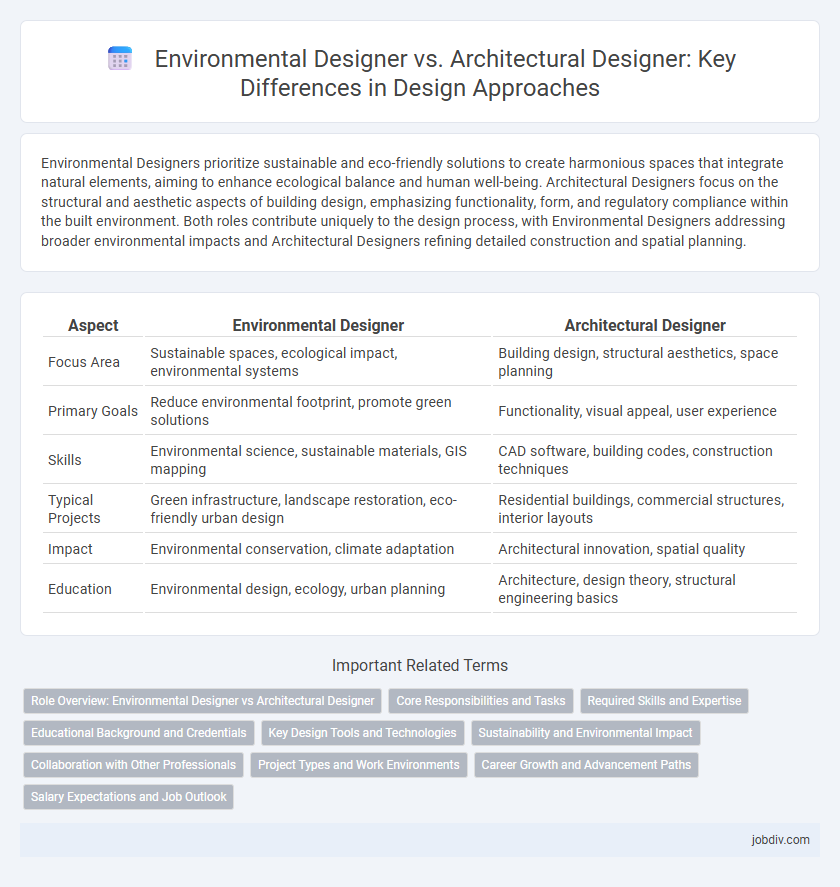Environmental Designers prioritize sustainable and eco-friendly solutions to create harmonious spaces that integrate natural elements, aiming to enhance ecological balance and human well-being. Architectural Designers focus on the structural and aesthetic aspects of building design, emphasizing functionality, form, and regulatory compliance within the built environment. Both roles contribute uniquely to the design process, with Environmental Designers addressing broader environmental impacts and Architectural Designers refining detailed construction and spatial planning.
Table of Comparison
| Aspect | Environmental Designer | Architectural Designer |
|---|---|---|
| Focus Area | Sustainable spaces, ecological impact, environmental systems | Building design, structural aesthetics, space planning |
| Primary Goals | Reduce environmental footprint, promote green solutions | Functionality, visual appeal, user experience |
| Skills | Environmental science, sustainable materials, GIS mapping | CAD software, building codes, construction techniques |
| Typical Projects | Green infrastructure, landscape restoration, eco-friendly urban design | Residential buildings, commercial structures, interior layouts |
| Impact | Environmental conservation, climate adaptation | Architectural innovation, spatial quality |
| Education | Environmental design, ecology, urban planning | Architecture, design theory, structural engineering basics |
Role Overview: Environmental Designer vs Architectural Designer
Environmental Designers focus on creating sustainable and eco-friendly solutions that integrate natural and built environments, emphasizing landscape, urban planning, and ecological impact. Architectural Designers primarily concentrate on designing building structures, focusing on spatial functionality, aesthetics, and regulatory compliance in construction. Both roles require collaboration but differ in scope, with Environmental Designers addressing broader environmental contexts and Architectural Designers targeting detailed building design.
Core Responsibilities and Tasks
Environmental designers concentrate on creating sustainable, functional spaces that integrate natural and built environments, focusing on landscape, urban planning, and ecological impact. Architectural designers specialize in building structures, emphasizing aesthetics, structural integrity, and compliance with building codes. Both roles require collaboration with multidisciplinary teams, but environmental designers prioritize environmental sustainability while architectural designers focus on architectural innovation and construction feasibility.
Required Skills and Expertise
Environmental designers specialize in integrating sustainable practices and ecological principles into spatial planning, requiring expertise in environmental science, landscape architecture, and urban ecology. Architectural designers focus on building aesthetics, structural systems, and compliance with construction codes, demanding proficiency in architectural software, engineering fundamentals, and design theory. Both roles benefit from strong communication skills and project management, yet environmental designers prioritize ecological impact assessment while architectural designers emphasize structural innovation and occupant experience.
Educational Background and Credentials
Environmental designers typically hold degrees in environmental design, landscape architecture, or urban planning, emphasizing sustainable and ecological principles. Architectural designers usually earn degrees in architecture or architectural engineering, focusing on building design, construction techniques, and regulatory codes. Professional credentials for environmental designers may include LEED certification, while architectural designers often pursue licensure through the Architect Registration Examination (ARE).
Key Design Tools and Technologies
Environmental designers primarily use tools like Geographic Information Systems (GIS), AutoCAD, and 3D modeling software to analyze and create sustainable landscapes and urban spaces. Architectural designers rely heavily on Building Information Modeling (BIM), Revit, and Computer-Aided Design (CAD) software to develop detailed building plans and structural designs. Both roles increasingly integrate virtual reality (VR) and parametric design technologies to enhance spatial visualization and optimize design precision.
Sustainability and Environmental Impact
Environmental designers prioritize sustainable solutions by integrating renewable materials, energy-efficient systems, and ecological conservation into their projects, minimizing environmental footprint. Architectural designers focus on creating functional and aesthetic building designs but increasingly incorporate green building standards such as LEED certification and passive solar design to enhance sustainability. Both roles contribute to reducing environmental impact, yet environmental designers emphasize broader ecosystem health and resource management beyond individual structures.
Collaboration with Other Professionals
Environmental designers and architectural designers collaborate closely with engineers, urban planners, and sustainability experts to integrate ecological considerations into building projects. Environmental designers prioritize ecosystem health and sustainable materials, working alongside landscape architects and environmental consultants to minimize environmental impact. Architectural designers focus on structural integrity and aesthetics, coordinating with construction managers and interior designers to ensure functional and visually appealing spaces.
Project Types and Work Environments
Environmental designers primarily focus on landscape, urban planning, and sustainable projects, creating outdoor spaces that integrate natural and built environments. Architectural designers concentrate on building structures, including residential, commercial, and institutional projects, emphasizing interior and exterior architectural elements. Work environments for environmental designers often include fieldwork and collaboration with civil engineers, while architectural designers typically work in offices engaging with clients, contractors, and regulatory agencies.
Career Growth and Advancement Paths
Environmental designers specialize in sustainable and eco-friendly design solutions, focusing on integrating natural elements and reducing environmental impact, which aligns with the increasing demand for green building certifications like LEED. Architectural designers concentrate on building functionality, structural integrity, and aesthetic appeal, often progressing to roles such as licensed architects or project managers with opportunities in large-scale commercial or urban development projects. Career growth for environmental designers often leads to roles in sustainability consulting or urban planning, while architectural designers typically advance through professional licensure and specialization in design, construction management, or real estate development.
Salary Expectations and Job Outlook
Environmental designers typically earn between $50,000 and $80,000 annually, with growing demand driven by sustainability initiatives and urban green space development. Architectural designers often command higher salaries, ranging from $60,000 to $90,000, reflecting their specialized skills in building design and regulatory compliance. Job outlook for environmental designers is projected to grow by 5-7% due to increasing environmental awareness, while architectural designers face steady demand at around 3-5% growth linked to construction industry trends.
Environmental Designer vs Architectural Designer Infographic

 jobdiv.com
jobdiv.com